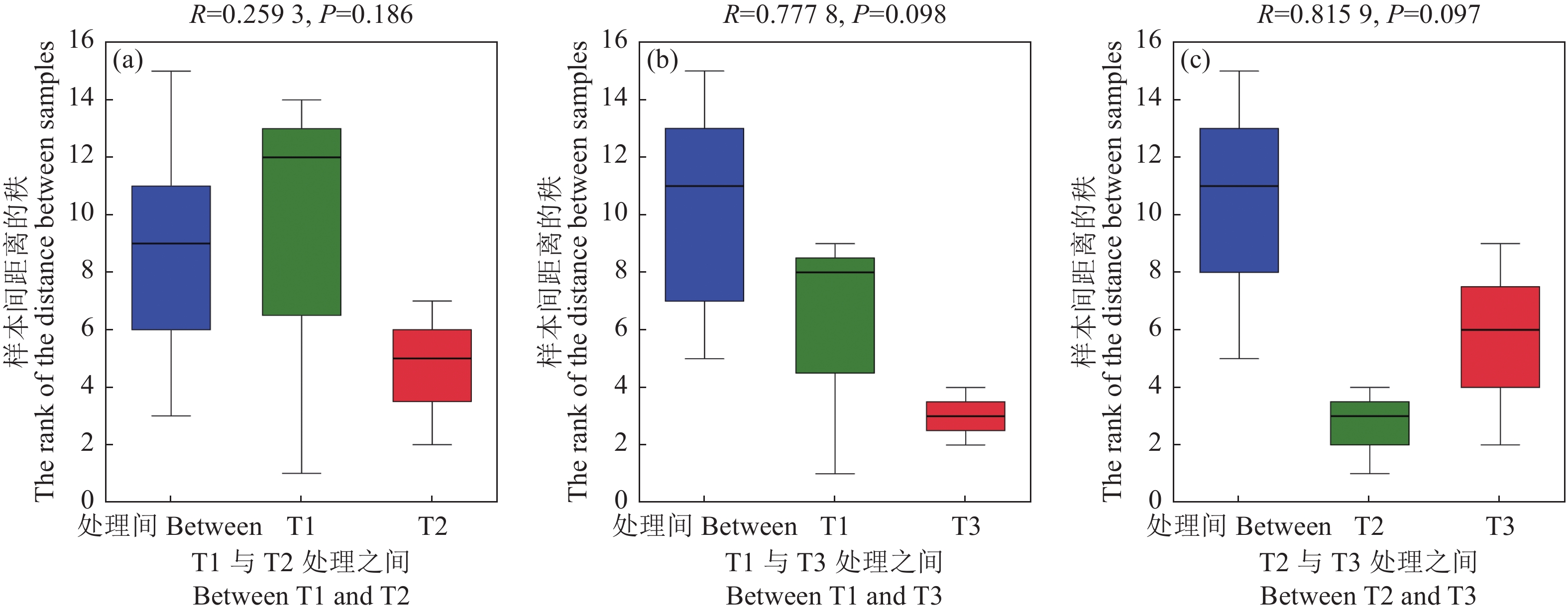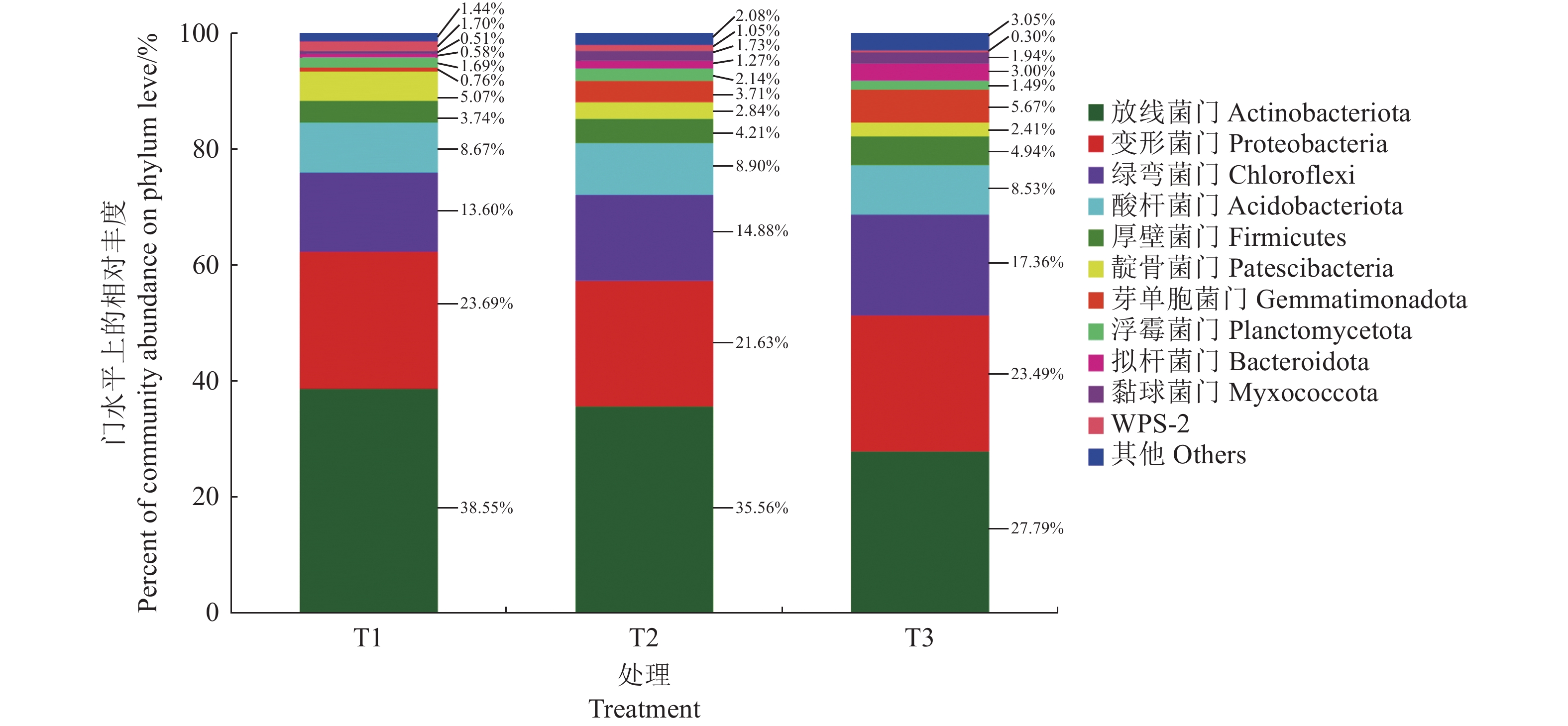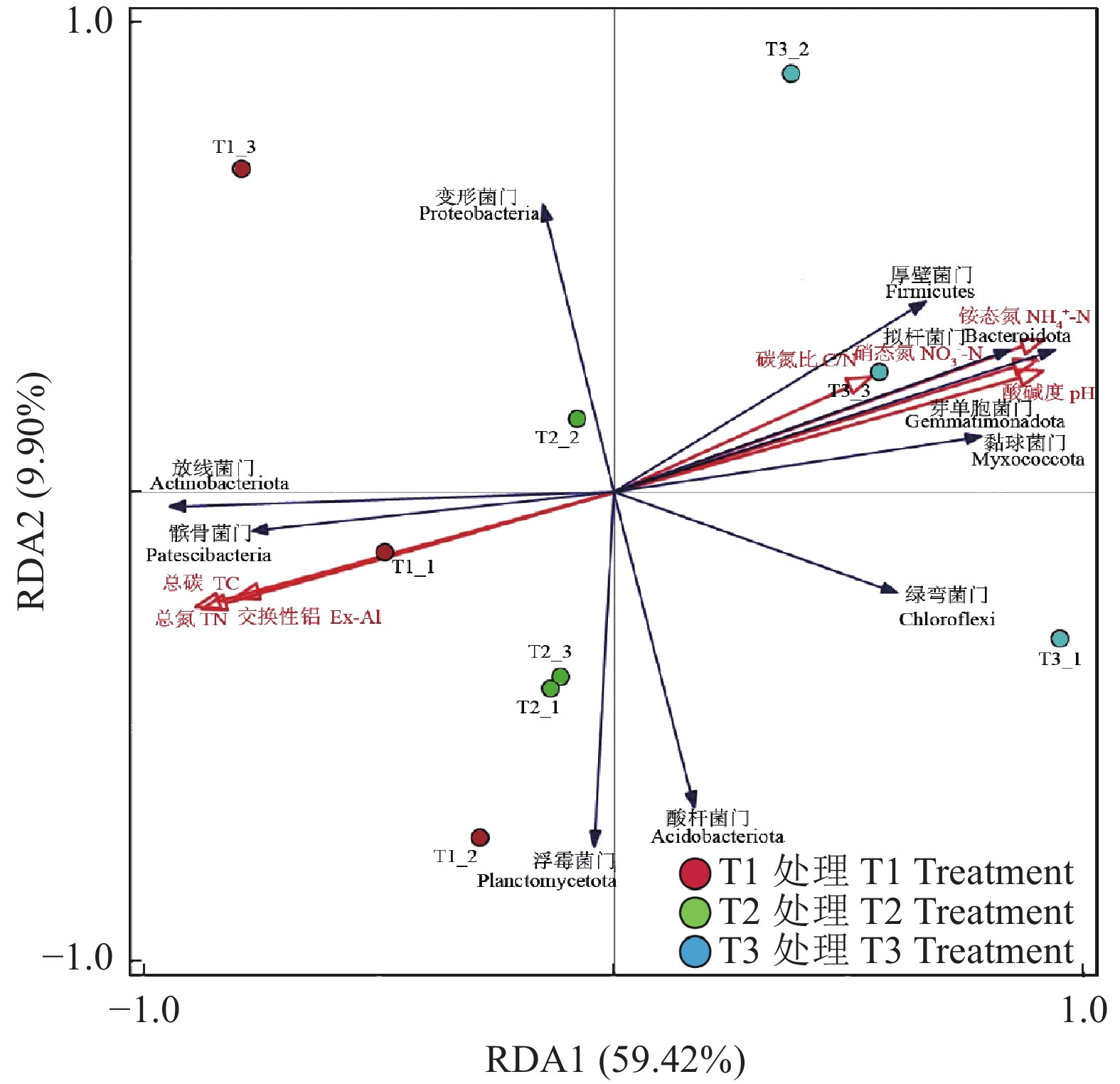Effects of Quicklime Application on Chemical Properties and Microbial Community of Highly Acidic Pomelo Orchard Soil
-
摘要:目的 研究生石灰对蜜柚果园强酸性土壤化学性质和细菌群落结构的影响,为蜜柚果园强酸性土壤的治理提供理论依据。方法 通过培育试验,设置不同生石灰用量处理,分别为0 g·kg−1(对照,T1)、1.2 g·kg−1(T2)、2.4 g·kg−1(T3),采用化学分析和高通量测序技术,探究不同生石灰施用量处理90 d后蜜柚果园土壤酸度、碳氮含量、细菌群落多样性和组成的变化,利用相关性分析研究细菌群落结构与土壤化学性质的相关性。结果 与未添加生石灰的对照处理相比,蜜柚果园强酸性土壤施用生石灰后,土壤pH值增加0.91~1.70,交换性铝降低60.00%~99.17%,总碳、总氮分别增加10.27%~39.29%、12.84%~34.86%,铵态氮降低27.74%~33.84%,硝态氮增加3.45%~42.70%。随生石灰施用量的增加,土壤细菌Chao1指数、ACE指数和Shannon指数呈显著增加趋势,增幅分别为47.68%~74.15%、46.40%~73.70%、9.53%~14.95%。放线菌门(Actinobacteriota)和变形菌门(Proteobacteria)是3个处理的优势菌门(相对丰度>20%),嗜酸栖热菌属(Acidothermus)是优势菌属,且pH越低,相对丰度越高。蜜柚果园强酸性土壤施用生石灰增加绿弯菌门(Chloroflexi)、拟杆菌门(Bacteroidota)和厚壁菌门(Firmicutes)的相对丰度,提高芽单胞菌属(Gemmatimonas)和小单胞菌属(Micromonospora)的相对丰度。冗余分析(RDA)结果显示,化学性质总共解释69.32%的土壤细菌群落结构变化,其中pH影响最大。结论 蜜柚果园强酸性土壤施用生石灰能显著提升土壤pH,降低交换性铝,维持土壤总碳、总氮含量,增加土壤硝态氮含量,提高细菌群落结构的多样性和丰富度。建议蜜柚果园强酸性土壤生石灰用量为2.4 g·kg−1。Abstract:Objective Effects of quicklime application on the chemical properties and microbial community of highly acidic pomelo orchard soil were analyzed to improve land management.Method In a pot experiment, quicklime were added to the highly acidic pomelo orchard soil in a dosage of 0 g·kg−1 (T1 as control), 1.2 g·kg−1 (T2), or 2.4 g·kg−1 (T3). After 90 d, chemical analysis and high-throughput sequencing were conducted to determine the acidity and carbon and nitrogen contents as well as the microbial diversity and structure in the soil. The collected data were used to statistically analyze correlation among them.Result The quicklime applications raised the pomelo orchard soil pH by 0.91–1.70, decreased the content of exchangeable aluminum by 60.00%–99.17% and that of ammonium nitrogen by 27.74%–33.84%, while increased the contents of total carbon by 10.27%–39.29%, nitrogen by 12.84%–34.86%, and nitrate nitrogen by 3.45%–42.70% over control. With increasing quicklime dosage, the soil bacteria Chao1, ACE, and Shannon indices significantly increased in the ranges of 47.68%–74.15%, 46.40%–73.70%, and 9.53%–14.95%, respectively. The dominant bacteria phyla in the soils under all 3 treatments were Actinobacteriota and Proteobacteria with a relative abundance greater than 20%. Acidothermus was the dominant genus with higher relative abundance at lower pHs. Overall, the relative abundance of Chloroflexi, Bacteroidota, Firmicutes, Gemmatimonas, and Micromonospora increased with the amount of quicklime applied. The redundancy analysis (RDA) indicated that soil chemistry explained 69.32% of the changes in the microbial community and that pH was the most important affecting factor.Conclusion Addition of quicklime to a highly acidic pomelo orchard soil raised the pH and the contents of carbon, nitrogen, and nitrate nitrogen, reduced the exchangeable aluminum, and improved the diversity and richness of microbial community in the soil. It is recommended that the amount of quicklime in the highly acidic soil of the pomelo orchard is 2.4 g·kg−1.
-
Keywords:
- Quicklime /
- acidic soil /
- soil pH /
- bacterial communities
-
0. 引言
【研究意义】杂交兰Cymbidium hybrid是由国兰和大花蕙兰作为亲本杂交培育而成的一类兰花的特称,其集国兰和大花蕙兰的开花特征于一身[1],花期长,有花观花、无花观叶,观赏和经济价值高,是目前市场上颇具发展潜力的兰花品种[2]。【前人研究进展】近年来,不同学者对杂交兰组织培养技术[3-6]、栽培技术[7-8]、四倍体诱导[9-10]、分子鉴定[11-13]、花期调控[14-15]等方面进行了研究。但杂交兰花期调控的研究局限于高山处理、激素处理、喷施次数等措施对杂交兰开花的影响,因为花期调控技术的不成熟,往往使杂交兰的花期与最佳销售期擦肩而过[16],为此制约杂交兰产业化发展的进程。花芽分化特性的研究是进行花期调控的基础[17]。植物花芽分化是一个复杂的形态建成过程,在花芽分化的过程中,除了形态的改变,更伴随着复杂的生理生化变化[18-19]。【本研究切入点】目前,兰科植物花芽分化方面的研究多集中于大花蕙兰[20-21]、蝴蝶兰[22-23]和卡特兰[24]等,而对杂交兰花芽分化过程中的形态变化及其相关生理指标的变化规律的研究还未见相关报道。【拟解决的关键问题】本研究以杂交兰品种‘黄金小神童’为材料,对杂交兰花芽分化过程的不同阶段进行形态解剖观测、植株外部形态特征观察,对花芽分化过程中可溶性糖、可溶性蛋白、淀粉含量和POD活性及CAT活性等生理生化指标变化进行测定,以期为后期杂交兰花期调控和成花机理研究提供科学依据。
1. 材料与方法
1.1 试验材料
供试材料为成熟期基本一致的杂交兰品种‘黄金小神童’(Cymbidium Golden Elf‘Sun-dust’),由福建省农业科学院作物研究所花卉研究中心种质资源圃提供。
1.2 花芽分化过程的形态观测
采取的花芽用去离子水冲洗后,剥去苞片,并记录下芽的长、宽、高。用于石蜡切片的芽,取样后迅速投入FAA固定液中,抽气固定,后经乙醇脱水、松节油透明、石蜡浸泡、石蜡包埋、切片机切片、明胶液贴片、番红固绿染色、树胶封片等步骤,完成石蜡切片的制作,最后显微镜观察并拍照。试验于2017年7月初至9月初进行,间隔5~7 d取样1次。
1.3 花芽分化过程中的生理指标测定
以发育进程基本一致的带花芽杂交兰植株的叶片为材料,根据花芽分化进程,在各个不同分化期取样进行生理指标的测定,每次取样约1 g,磨碎,根据不同生理指标加入相应试剂进行试验。可溶性糖和淀粉含量的测定采用蒽酮比色法,620 nm处测定吸光值;可溶性蛋白含量的测定采用考马斯亮蓝法,595 nm处测定吸光值;POD活性的测定采用愈创木酚法,计算公式中以每毫克组织蛋白每分钟内能转化1 μg底物所需要的酶量为1个酶活性单位(U);CAT活性的测定采取可见光法,计算公式中以每毫克组织蛋白每秒钟内分解1 μmol H2O2所需要的酶量为1个酶活性单位(U)。
1.4 数据分析
数据采用Excel和SPSS统计软件进行分析。
2. 结果与分析
2.1 杂交兰花芽分化时期及主要特征
根据杂交兰‘黄金小神童’花芽发生和发育的特点,其分化时期可划分为6个阶段(图 1)。在未分化期,芽点从假鳞茎基部叶腋处发出,生长锥顶端呈半圆状凸起,表面平滑整齐(图 1-A),此时,芽高度为0.622~0.638 cm;随后,生长锥进一步伸长增大,呈半球形,有明显凸出状(图 1-B),也标志着芽体进入到花序原基分化期,此时,芽高度为0.678~0.683 cm;随着植株不断生长,不断膨大的生长锥的顶部和侧方分化出的多个凸起,为小花原基(图 1-C),说明此时进入小花原基分化期,芽高度为0.710~0.784 cm;小花原基继续增大变宽,继而从边缘分化出3个凸起,即为萼片原基(图 1-D),但纵切面上只能看到2个萼片原基凸起,此时,芽高度约为0.928~0.984 cm;萼片原基不断伸长弯曲,在其内侧继续分化出花瓣原基凸起(图 1-E);花瓣原基不断伸长,其内侧又分化出新的凸起,为合蕊柱原基;合蕊柱继续生长,其顶端分化出2个花粉块,象征着花芽进入合蕊柱及花粉块分化期(图 1-F~I)。
![]() 图 1 杂交兰‘黄金小神童’花芽分化形态解剖注:A~E依次为:未分化期、花序原基分化期、小花原基分化期、萼片原基分化期、花瓣原基分化期;F~I:合蕊柱及花粉块分化期;1:生长锥;2:花序原基;3:小花原基;4:萼片原基;5:花瓣原基;6:合蕊柱原基;7:唇瓣;8:花瓣;9:花粉块;10:蕊喙。Figure 1. Anatomy of flower bud differentiation of Golden Elf 'Sun-dust'Note:A-E represent stages of undifferentiation, inflorescence primordium differentiation, floret primordium differentiation, sepal primordium differentiation, and petal primordium differentiation, respectively; F-I represents serial column and pollinia differentiation stages. 1: growth corn; 2: inflorescence primorium; 3: flower bud primordium; 4: sepal primordium; 5: petal primordium; 6: column primodium; 7: labellum 8: petal; 9: pollinium; 10: rostellum.
图 1 杂交兰‘黄金小神童’花芽分化形态解剖注:A~E依次为:未分化期、花序原基分化期、小花原基分化期、萼片原基分化期、花瓣原基分化期;F~I:合蕊柱及花粉块分化期;1:生长锥;2:花序原基;3:小花原基;4:萼片原基;5:花瓣原基;6:合蕊柱原基;7:唇瓣;8:花瓣;9:花粉块;10:蕊喙。Figure 1. Anatomy of flower bud differentiation of Golden Elf 'Sun-dust'Note:A-E represent stages of undifferentiation, inflorescence primordium differentiation, floret primordium differentiation, sepal primordium differentiation, and petal primordium differentiation, respectively; F-I represents serial column and pollinia differentiation stages. 1: growth corn; 2: inflorescence primorium; 3: flower bud primordium; 4: sepal primordium; 5: petal primordium; 6: column primodium; 7: labellum 8: petal; 9: pollinium; 10: rostellum.2.2 杂交兰花芽分化过程中可溶性糖和淀粉含量的变化
由图 2可知,随着花芽分化进程,杂交兰叶片中的可溶性糖含量的变化趋势为上升-下降-上升-下降,可溶性糖含量在分化前期不断升高,在小花原基分化期时达到峰值,在进入萼片原基分化期后,可溶性糖含量开始下降,随后进入花瓣原基分化期,又出现上升的趋势,紧接着进入合蕊柱及花粉块分化期,含量又开始下降。运用SPSS软件分析发现,不同分化时期可溶性糖含量之间具有显著性差异。杂交兰叶片中的淀粉含量的具体变化趋势与可溶性糖含量的变化趋势一致,且在小花原基分化期时含量最高。经显著性差异分析发现,淀粉含量除了在小花原基分化期与其他分化期间具有显著性差异外,其他5个分化期间不存在显著性差异,总体上呈现出先上升后下降的变化趋势。
![]() 图 2 杂交兰‘黄金小神童’花芽分化过程中可溶性糖和淀粉含量的变化Figure 2. Changes on soluble sugar and starch contents of Golden Elf 'Sun-dust' during flower bud differentiationNote: A-F were stages of undifferentiation, inflorescence primordium differentiation, floret primordium differentiation, sepal primordium differentiation, petal primordium differentiation column and pollinia differentiation.The different lowercase letters in the figure showed significant differences(P < 0.05), the same as fig. 3-4.
图 2 杂交兰‘黄金小神童’花芽分化过程中可溶性糖和淀粉含量的变化Figure 2. Changes on soluble sugar and starch contents of Golden Elf 'Sun-dust' during flower bud differentiationNote: A-F were stages of undifferentiation, inflorescence primordium differentiation, floret primordium differentiation, sepal primordium differentiation, petal primordium differentiation column and pollinia differentiation.The different lowercase letters in the figure showed significant differences(P < 0.05), the same as fig. 3-4.2.3 杂交兰花芽分化过程中可溶性蛋白含量的变化
由图 3可知,杂交兰叶片中的可溶性蛋白含量随着花芽分化进程呈现先上升后下降的趋势,在分化前期不断升高,在萼片原基分化期时,可溶性蛋白含量最高,随后持续下降,直至合蕊柱及花粉块分化期时降到最低值,仅为萼片原基分化期时的22.17%。差异性分析结果显示,可溶性蛋白含量在萼片原基分化期与其他分化时期间具有显著性差异。
2.4 杂交兰花芽分化过程中POD和CAT酶活性的变化
由图 4可知,杂交兰叶片中POD活性和CAT活性随着花芽分化进程均呈现先下降后上升的趋势。POD活性在花芽分化前期缓慢下降,各分化时期无显著性差异,在萼片原基分化期时处于最低值,在花芽分化后期急速上升,各分化时期存在显著性差异,在合蕊柱及花粉块分化期时达到最高值。CAT活性在未分化期时最高,随着花芽分化进程先急剧下降,在小花原基分化期时降到最低值,而后又开始上升,CAT活性在花芽分化各时期差异显著。
3. 讨论与结论
花芽分化是复杂的生理生化和形态分化过程,是植物从营养生长进入生殖生长的关键时期[25]。本研究将杂交兰‘黄金小神童’花芽分化过程分为未分化期、花序原基分化期、小花原基分化期、萼片原基分化期、花瓣原基分化期和合蕊柱及花粉块分化期6个阶段;与蝴蝶兰[23]、黄花美冠兰[26]文心兰[27]花芽分化的研究结果大致相同,而与大花蕙兰[28]、罗汉果[29]的花芽分化过程划分结果有所不同,说明不同植物种类甚至同为兰科植物,其花芽形态分化时期的划分存在较大差异。
植物花芽分化过程中,需要消耗大量的营养物质[30]。有研究表明,碳水化合物是植物完成花芽分化进程的重要物质基础[31-32]。在本研究中,杂交兰叶片中的可溶性糖和淀粉含量随着花芽分化进程,在花芽分化前期不断积累,在小花原基分化期达到峰值,随后开始出现下降,说明叶片中充足的可溶性糖和淀粉含量有利于杂交兰花芽分化的进行。可溶性蛋白是花器官形态建成的物质基础,在花芽分化时需要量较大。韦莉等[23]研究发现,蝴蝶兰花芽分化期间叶片中可溶性蛋白含量先上升后下降;龚湉[33]的研究发现,寒兰叶片中可溶性蛋白含量随花芽分化进程先下降后上升,说明在不同植物花芽分化过程中,可溶性蛋白的变化趋势存在差异。本研究结果显示,杂交兰叶片中可溶性蛋白含量在花芽分化期间呈现先上升后下降的趋势,在萼片原基分化期时达到最高值,说明在花芽分化前期积累足够的蛋白质可为后续花芽分化的推进提供保障。
花芽分化过程中,除了营养物质的积累,还需要一系列酶的参与调控。孔德政等[34]的研究发现,在碗莲花芽分化过程中,莲叶中的CAT活性呈上升趋势,POD活性呈先上升后下降的趋势;艾星梅等[35]的研究结果显示,6个马铃薯品种花芽分化期POD、CAT活性均呈现先升后降的变化趋势;臧纱纱等[36]的研究发现,线辣椒花芽分化过程中,POD活性呈现先降后升的变化趋势。不同植物花芽分化进程中,不同酶活性的变化趋势也存在较大差异。本研究中杂交兰叶片POD和CAT活性随花芽分化进程呈现先下降后上升的趋势,POD活性在萼片原基分化期时处于最低值,在花芽分化后期急速上升;CAT活性在小花原基分化期时降到最低值,而后又开始上升。花芽分化后期POD和CAT活性的上升,可能有效避免杂交兰受到活性氧和氢氧根离子的伤害。
花芽分化是有花植物发育中最为关键的阶段,是在植物体内外因子的共同作用和相互协调下完成的。本研究通过对杂交兰花芽分化过程中的形态及生理变化进行研究,了解杂交兰花芽分化过程中的形态和相关代谢产物含量及酶活性的变化,界定花芽分化的各个阶段,不仅可以为后续制定杂交兰栽培管理措施提供依据,保障杂交兰花芽分化顺利进行,也可以为花期调控和成花机理研究提供基础资料。
-
图 5 土壤化学性质与细菌群落结构组成热图分析
Ex-Al——交换性铝;TC——总碳;TN——总氮;NH4+-N——铵态氮;NO3−-N——硝态氮。***——P<0.001.
Figure 5. Heat map analysis on chemical properties and microbial structure of orchard soil
Ex-Al: Exchangeable aluminum; TC: Total carbon; TN: Total nitrogen; NH4+-N: Ammonium nitrogen; NO3−-N: Nitrate nitrogen. *** indicates P<0.001.
表 1 不同生石灰用量蜜柚果园土壤化学性质
Table 1 Chemistry of pomelo orchard soil under varied quicklime treatments
处理
TreatmentpH 交换性铝
Exchangeable aluminum/
(cmol·kg−1)总碳
Total carbon/
(g·kg−1)总氮
Total nitrogen/
(g·kg−1)C/N
Ratio of carbon to
nitrogen铵态氮
Ammonium nitrogen/
(mg·kg−1)硝态氮
Nitrate nitrogen/
(mg·kg−1)T1 3.96±0.01 c 1.20±0.02 a 11.30±0.20 c 1.09±0.00 c 10.37±0.18 a 3.93±0.03 a 18.57±1.22 b T2 4.87±0.03 b 0.48±0.02 b 12.46±0.49 b 1.23±0.01 b 10.13±0.46 b 2.84±0.03 b 19.21±1.03 b T3 5.66±0.01 a 0.01±0.01 c 15.74±0.32 a 1.47±0.02 a 10.73±0.21 a 2.60±0.13 c 26.50±0.22 a 表中数据为平均值±标准误差,n=3。不同小写字母表示处理间显著差异(P<0.05)。下表同。
Data are average±standard error, n=3; those with different lowercase letters indicate significant differences between treatments (P<0.05). Same for below.表 2 不同生石灰用量土壤细菌群落结构α多样性
Table 2 Alpha diversity of microbial community in soils under varied quicklime treatments
处理
TreatmentOTU数量
OTU number覆盖率
Coverage/%Chao1 指数
Chao1 indexACE 指数
ACE indexShannon 指数
Shannon indexSimpson 指数
Simpson indexT1 1220±54 c 99.58±0.03 a 1501.4±63.8 c 1510.8±55.3 c 5.35±0.13 c 0.0123±0.0023 a T2 1765±30 b 99.30±0.04 b 2217.2±124.9 b 2211.9±135.2 b 5.86±0.00 b 0.0069±0.0002 b T3 2094±22 a 99.12±0.11 c 2614.7±147.3 a 2624.3±133.7 a 6.15±0.02 a 0.0052±0.0003 b -
[1] 鲁艳红, 廖育林, 聂军, 等. 我国南方红壤酸化问题及改良修复技术研究进展 [J]. 湖南农业科学, 2015(3):148−151. LU Y H, LIAO Y L, NIE J, et al. Status of red soil acidification and its amelioration technologies in South China [J]. Hunan Agricultural Sciences, 2015(3): 148−151.(in Chinese)
[2] 沈仁芳, 赵学强. 酸性土壤可持续利用 [J]. 农学学报, 2019, 9(3):16−20. SHEN R F, ZHAO X Q. The sustainable use of acid soils [J]. Journal of Agriculture, 2019, 9(3): 16−20.(in Chinese)
[3] 徐仁扣, 李九玉, 周世伟, 等. 我国农田土壤酸化调控的科学问题与技术措施 [J]. 中国科学院院刊, 2018, 33(2):160−167. XU R K, LI J Y, ZHOU S W, et al. Scientific issues and controlling strategies of soil acidification of croplands in China [J]. Bulletin of Chinese Academy of Sciences, 2018, 33(2): 160−167.(in Chinese)
[4] 李歆博, 林伟杰, 李湘君, 等. 琯溪蜜柚园土壤酸化特征研究 [J]. 经济林研究, 2020, 38(1):169−176. LI X B, LIN W J, LI X J, et al. Research on soil acidification characteristics of Guanxi pomelo orchards [J]. Non-Wood Forest Research, 2020, 38(1): 169−176.(in Chinese)
[5] 吴道铭, 傅友强, 于智卫, 等. 我国南方红壤酸化和铝毒现状及防治 [J]. 土壤, 2013, 45(4):577−584. WU D M, FU Y Q, YU Z W, et al. Status of red soil acidification and aluminum toxicity in South China and prevention [J]. Soils, 2013, 45(4): 577−584.(in Chinese)
[6] 张玲玉, 赵学强, 沈仁芳. 土壤酸化及其生态效应 [J]. 生态学杂志, 2019, 38(6):1900−1908. ZHANG L Y, ZHAO X Q, SHEN R F. Soil acidification and its ecological effects [J]. Chinese Journal of Ecology, 2019, 38(6): 1900−1908.(in Chinese)
[7] HALING R, SIMPSON R, DELHAIZE E, et al. Effect of lime on root growth, morphology and the rhizosheath of cereal seedlings growing in an acid soil [J]. Plant and Soil, 2010, 327: 199−212. DOI: 10.1007/s11104-009-0047-5
[8] 袁金华, 徐仁扣. 生物质炭对酸性土壤改良作用的研究进展 [J]. 土壤, 2012, 44(4):541−547. YUAN J H, XU R K. Research progress of amelioration effects of biochars on acid soils [J]. Soils, 2012, 44(4): 541−547.(in Chinese)
[9] 易杰祥, 吕亮雪, 刘国道. 土壤酸化和酸性土壤改良研究 [J]. 华南热带农业大学学报, 2006(1):23−28. YI J X, LÜ L X, LIU G D. Research on soil acidification and acidic soil’s melioration [J]. Journal of South China University of Tropical Agriculture, 2006(1): 23−28.(in Chinese)
[10] 汪瑞清, 肖运萍, 魏林根, 等. 土壤改良剂对红壤性低产地的应用效果比较研究 [J]. 江西农业学报, 2011, 23(3):75−77,81. WANG R Q, XIAO Y P, WEI L G, et al. Comparative study on effects of soil amendment application in low-yielding red-soil land [J]. Acta Agriculturae Jiangxi, 2011, 23(3): 75−77,81.(in Chinese)
[11] 张思文, 陈晓辉, 蔡远扬, 等. 酸性红壤添加石灰对甜玉米幼苗生长、养分累积和土壤理化性质的影响 [J]. 中国农业大学学报, 2022, 27(3):41−52. DOI: 10.11841/j.issn.1007-4333.2022.03.06 ZHANG S W, CHEN X H, CAI Y Y, et al. Effects of supplement of lime in acidic red soil on the sweet maize seedling growth, nutrient accumulation, and soil physi-chemical properties [J]. Journal of China Agricultural University, 2022, 27(3): 41−52.(in Chinese) DOI: 10.11841/j.issn.1007-4333.2022.03.06
[12] 段媛媛, 吴佳奇, 周武先, 等. 不同改良剂对连作大黄产量及其土壤肥力的影响 [J]. 南方农业学报, 2021, 52(3):753−761. DUAN Y Y, WU J Q, ZHOU W X, et al. Effects of different amendments on the yield of Rheum officinale Baill. and rhizospheric soil fertility under continuous cropping system [J]. Journal of Southern Agriculture, 2021, 52(3): 753−761.(in Chinese)
[13] 罗俊, 林兆里, 李诗燕, 等. 不同土壤改良措施对机械压实酸化蔗地土壤理化性质及微生物群落结构的影响 [J]. 作物学报, 2020, 46(4):596−613. DOI: 10.3724/SP.J.1006.2020.94102 LUO J, LIN Z L, LI S Y, et al. Effects of different soil improvement measures on soil physicochemical properties and microbial community structures in mechanically compacted acidified sugarcane field [J]. Acta Agronomica Sinica, 2020, 46(4): 596−613.(in Chinese) DOI: 10.3724/SP.J.1006.2020.94102
[14] 刘琼峰, 蒋平, 李志明, 等. 湖南省水稻主产区酸性土壤施用石灰的改良效果 [J]. 湖南农业科学, 2014(13):29−32. LIU Q F, JIANG P, LI Z M, et al. Amelioration effects of Liming on acid soil in main rice producing areas in Hunan [J]. Hunan Agricultural Sciences, 2014(13): 29−32.(in Chinese)
[15] 王怀嵩, 张涛. 农业土壤健康评价体系研究进展 [J]. 生态与农村环境学报, 2022, 38(9):1093−1100. WANG H S, ZHANG T. Research progress of agricultural soil health evaluation system [J]. Journal of Ecology and Rural Environment, 2022, 38(9): 1093−1100.(in Chinese)
[16] 张影, 胡承孝, 谭启玲, 等. 施用石灰对温州蜜柑树体营养和果实品质及酸性柑橘园土壤养分有效性的影响 [J]. 华中农业大学学报, 2014, 33(4):72−76. ZHANG Y, HU C X, TAN Q L, et al. Effects of liming on nutrition status, quality of satsuma mandarin and acid soil nutrients availability of citrus orchard [J]. Journal of Huazhong Agricultural University, 2014, 33(4): 72−76.(in Chinese)
[17] 谢志南, 庄伊美, 王仁玑, 等. 福建亚热带果园土壤pH值与有效态养分含量的相关性 [J]. 园艺学报, 1997, 24(3):209−214. XIE Z N, ZHUANG Y M, WANG R J, et al. Correlation between soil pH and the contents of available nutrients in selected soils from three kinds of orchards at subtropical zone in Fujian [J]. Acta Horticulturae Sinica, 1997, 24(3): 209−214.(in Chinese)
[18] 鲁如坤. 土壤农业化学分析方法[M]. 北京: 中国农业科技出版社, 1999. [19] DENNIS K L, WANG Y W, BLATNER N R, et al. Adenomatous polyps are driven by microbe-instigated focal inflammation and are controlled by IL-10-producing T cells [J]. Cancer Research, 2013, 73(19): 5905−5913. DOI: 10.1158/0008-5472.CAN-13-1511
[20] XIAO H, WANG B, LU S B, et al. Soil acidification reduces the effects of short‐term nutrient enrichment on plant and soil biota and their interactions in grasslands [J]. Global Change Biology, 2020, 26: 4626−4637. DOI: 10.1111/gcb.15167
[21] 张义杰, 徐杰, 陆仁窗, 等. 生石灰对林下酸化土壤的调控作用及三七生长的影响 [J]. 应用生态学报, 2022, 33(4):972−980. ZHANG Y J, XU J, LU R C, et al. Modification of quicklime on acid soil under forest and their effect on the growth of Panax notoginseng [J]. Chinese Journal of Applied Ecology, 2022, 33(4): 972−980.(in Chinese)
[22] 胡敏, 向永生, 鲁剑巍. 石灰用量对酸性土壤pH值及有效养分含量的影响 [J]. 中国土壤与肥料, 2017(4):72−77. HU M, XIANG Y S, LU J W. Effects of lime application rates on soil pH and available nutrient content in acidic soils [J]. Soil and Fertilizer Sciences in China, 2017(4): 72−77.(in Chinese)
[23] 苏杨, 张俊涛, 李铤, 等. 4种改良材料对城市绿地酸性土壤的改良效果 [J]. 林业与环境科学, 2021, 37(4):62−68. SU Y, ZHANG J T, LI T, et al. Effects of four amendments on acidic soils of urban green space [J]. Forestry and Environmental Science, 2021, 37(4): 62−68.(in Chinese)
[24] 蔡东, 肖文芳, 李国怀. 施用石灰改良酸性土壤的研究进展 [J]. 中国农学通报, 2010, 26(9):206−213. CAI D, XIAO W F, LI G H. Advance on study of liming on acid soils [J]. Chinese Agricultural Science Bulletin, 2010, 26(9): 206−213.(in Chinese)
[25] LU X F, GILLIAM F S, GUO J Y, et al. Decrease in soil pH has greater effects than increase in above-ground carbon inputs on soil organic carbon in terrestrial ecosystems of China under nitrogen enrichment [J]. Journal of Applied Ecology, 2022, 59(3): 768−778. DOI: 10.1111/1365-2664.14091
[26] 曹文超, 宋贺, 王娅静, 等. 农田土壤N2O排放的关键过程及影响因素 [J]. 植物营养与肥料学报, 2019, 25(10):1781−1798. CAO W C, SONG H, WANG Y J, et al. Key production processes and influencing factors of nitrous oxide emissions from agricultural soils [J]. Journal of Plant Nutrition and Fertilizers, 2019, 25(10): 1781−1798.(in Chinese)
[27] ZHANG Y, ZHAO J, HUANG X Q, et al. Microbial pathways account for the pH effect on soil N2O production [J]. European Journal of Soil Biology, 2021, 106: 103337. DOI: 10.1016/j.ejsobi.2021.103337
[28] WEI Z, YANG T J, FRIMAN V P, et al. Trophic network architecture of root-associated bacterial communities determines pathogen invasion and plant health [J]. Nature Communications, 2015, 6(1): 1−9.
[29] 王海斌, 陈晓婷, 丁力, 等. 土壤酸度对茶树根际土壤微生物群落多样性影响 [J]. 热带作物学报, 2018, 39(3):448−454. WANG H B, CHEN X T, DING L, et al. Effect of soil acidity on microbial diversity in rhizospheric soils of tea plants [J]. Chinese Journal of Tropical Crops, 2018, 39(3): 448−454.(in Chinese)
[30] 陶玲, 李晓莉, 朱建强, 等. 施用生石灰对精养池塘浮游细菌群落结构和多样性的影响 [J]. 水生生物学报, 2017, 41(2):399−406. TAO L, LI X L, ZHU J Q, et al. Effects of quicklime application on community structure and diversity of bacterioplankton in intensive culture ponds [J]. Acta Hydrobiologica Sinica, 2017, 41(2): 399−406.(in Chinese)
[31] 宋宇, 王鹏, 韦月平. 不同稻田共作模式对土壤细菌群落结构的影响 [J]. 西北农业学报, 2020, 29(2):216−223. SONG Y, WANG P, WEI Y P. Effects of different co-cultivation patterns of rice field on soil bacterial communities structure [J]. Acta Agriculturae Boreali-Occidentalis Sinica, 2020, 29(2): 216−223.(in Chinese)
[32] 徐光泽, 席飞虎, 张重义. 施用生石灰对烤烟根际生物学特征及烟叶产质量的影响 [J]. 江西农业学报, 2014, 26(7):67−70. XU G Z, XI F H, ZHANG Z Y. Effects of using quick lime on biological characteristics of rhizospheric microorganisms of flue-cured tobacco, and yield and quality of tobacco leaves [J]. Acta Agriculturae Jiangxi, 2014, 26(7): 67−70.(in Chinese)
[33] GRIFFITHS R I, THOMSON B C, JAMES P, et al. The bacterial biogeography of British soils [J]. Environmental Microbiology, 2011, 13(6): 1642−1654. DOI: 10.1111/j.1462-2920.2011.02480.x
[34] CHEN L L, XU H B, WU S Y, et al. Plant and soil properties mediate the response of soil microbial communities to moderate grazing in a semiarid grassland of Northern China [J]. Journal of Environmental Management, 2021, 284: 112005. DOI: 10.1016/j.jenvman.2021.112005
[35] LIU L L, HUANG X Q, ZHANG J B, et al. Deciphering the relative importance of soil and plant traits on the development of rhizosphere microbial communities [J]. Soil Biology and Biochemistry, 2020, 148: 107909. DOI: 10.1016/j.soilbio.2020.107909
[36] SUN H, TERHONEN E, KOSKINEN K, et al. Bacterial diversity and community structure along different peat soils in boreal forest [J]. Applied Soil Ecology, 2014, 74: 37−45. DOI: 10.1016/j.apsoil.2013.09.010
[37] FAZI S, AMALFITANO S, PERNTHALER J, et al. Bacterial communities associated with benthic organic matter in headwater stream microhabitats [J]. Environmental Microbiology, 2005, 7(10): 1633−1640. DOI: 10.1111/j.1462-2920.2005.00857.x
[38] IBRAHIM M M, TONG C X, HU K, et al. Biochar-fertilizer interaction modifies N-sorption, enzyme activities and microbial functional abundance regulating nitrogen retention in rhizosphere soil [J]. Science of the Total Environment, 2020, 739: 140065. DOI: 10.1016/j.scitotenv.2020.140065
[39] 宋宇, 丛培东, 曲贵伟, 等. 不同复合种养模式稻田土壤细菌群落结构比较分析 [J]. 中国稻米, 2022, 28(3):47−51. SONG Y, CONG P D, QU G W, et al. Comparative analysis of bacterial community structure in paddy soil under different complex cultivation models [J]. China Rice, 2022, 28(3): 47−51.(in Chinese)
[40] 王明元, 侯式贞, 董涛, 等. 香蕉假茎生物炭对根际土壤细菌丰度和群落结构的影响[J]. 微生物学报, 2019, 59(7): 1363-1372. WANG M Y, HOU S Z, DONG T, et al. Effects of banana pseudostem biochar on bacterial abundance and community structure in rhizosphere soil[J]. Acta Microbiologica Sinica, 2019, 59(7): 1363-1372. (in Chinese)
[41] 杨星鹏, 张志斌, 朱笃. 小单胞菌属次级代谢产物及其生物活性研究进展 [J]. 天然产物研究与开发, 2019, 31:908−915,921. YANG X P, ZHANG Z B, ZHU D. Review on secondary metabolites and its biological activities from genus Micromonospora [J]. Natural Product Research and Developmen, 2019, 31: 908−915,921.(in Chinese)
[42] XIE F C, ZHANG G Y, ZHENG Q J, et al. Beneficial effects of mixing Kentucky bluegrass with red fescue via plant-soil interactions in black soil of northeast China [J]. Frontiers in Microbiology, 2020, 11: 556118. DOI: 10.3389/fmicb.2020.556118
[43] 王英成, 姚世庭, 金鑫, 等. 三江源区高寒退化草甸土壤细菌多样性的对比研究 [J]. 生态环境学报, 2022, 31(4):695−703. WANG Y C, YAO S T, JIN X, et al. Comparative study on soil bacterial diversity of degraded alpine meadow in the Sanjiangyuan region [J]. Ecology and Environmental Sciences, 2022, 31(4): 695−703.(in Chinese)
[44] LAUBER C L, HAMADY M, KNIGHT R, et al. Pyrosequencing-based assessment of soil pH as a predictor of soil bacterial community structure at the continental scale [J]. Applied and Environmental Microbiology, 2009, 75(15): 5111−5120. DOI: 10.1128/AEM.00335-09
[45] BRADY N C, WEIL R. The nature and properties of soils[M]. 14th ed. New Jersey: Prentice Hall, 2007.
[46] 王娟娟, 朱紫娟, 钱晓晴, 等. 全年稻麦秸秆还田对稻田土壤细菌群落结构的影响 [J]. 中国土壤与肥料, 2022(4):57−65. WANG J J, ZHU Z J, QIAN X Q, et al. Effects of year-round rice-wheat straw return on soil bacterial community structure in paddy fields [J]. Soil and Fertilizer Sciences in China, 2022(4): 57−65.(in Chinese)
-
期刊类型引用(14)
1. 陈露,李青女,郑佳桐,王奕晴,翟俊文,吴沙沙. 兰科植物花期调控技术及分子机理研究进展. 植物遗传资源学报. 2025(01): 1-13 .  百度学术
百度学术
2. 刘贝宁,陈发兴. 多效唑和乙烯利对西克刺桐花芽分化及成花基因表达的影响. 福建农业学报. 2024(04): 427-437 .  本站查看
本站查看
3. 李腾基,付志恵,陈鑫,黄洁衔,黄紫钦,张建霞. 不同植物生长调节剂对墨兰成花生理和开花性状的影响. 分子植物育种. 2024(17): 5777-5786 .  百度学术
百度学术
4. 黄洁衔,李腾基,黄紫钦,逯有法,张建霞. 墨兰花芽形态分化及生理特性研究. 北方园艺. 2023(03): 56-63 .  百度学术
百度学术
5. 金洲,卢山,江俊浩,李寿仁,张楠,江晓钰,吴凡. 园艺植物花芽分化影响因素及机理研究进展. 园艺学报. 2023(05): 1151-1164 .  百度学术
百度学术
6. 张超,李彤妤,裴珂,段九菊. 乙炔催花对观赏凤梨糖代谢的影响. 核农学报. 2023(12): 2478-2484 .  百度学术
百度学术
7. 周荣,贺琪馨,陆楚桥. 植物生长调节剂对建兰开花的调控作用研究. 广东农业科学. 2023(09): 165-172 .  百度学术
百度学术
8. 温玥,郝志超,孙天雨,苏淑钗,王湘南. 油茶花芽分化过程中营养物质和内源激素的变化规律. 经济林研究. 2023(04): 31-39 .  百度学术
百度学术
9. 张英杰,李奥,吕云飞,孙纪霞,刘民晓,张京伟,刘学庆,刘晓华,郭文姣,郭对田. 蝴蝶兰成花过程内源激素含量的变化和植物生长调节剂的作用. 热带亚热带植物学报. 2022(01): 104-110 .  百度学术
百度学术
10. 孔兰,林榕燕,樊荣辉,林兵,方能炎,钟淮钦. 杂交兰花瓣类黄酮成分分析及其对花色的影响. 西北植物学报. 2022(10): 1711-1719 .  百度学术
百度学术
11. 段秋笛,杨旭,赵焱,卢丽晶,崔秀伟,梁宏伟. 连香树花芽发育过程中的生理生化特性研究. 湖北农业科学. 2022(22): 89-93 .  百度学术
百度学术
12. 吴洁秋,朱根发,王凤兰,杨凤玺. 竹叶兰花器官发育过程及生理特性研究. 热带作物学报. 2021(01): 140-148 .  百度学术
百度学术
13. 李霖,李婷婷,杨坤,张志忠,吴菁华. 低温抑制中国水仙花芽分化的生理生化机制. 福建农业学报. 2021(04): 412-417 .  本站查看
本站查看
14. 董晓晓,别沛婷,袁涛. 3个牡丹品种花芽分化过程形态及叶片碳水化合物质量分数变化. 东北林业大学学报. 2020(07): 34-39 .  百度学术
百度学术
其他类型引用(4)





 下载:
下载:









